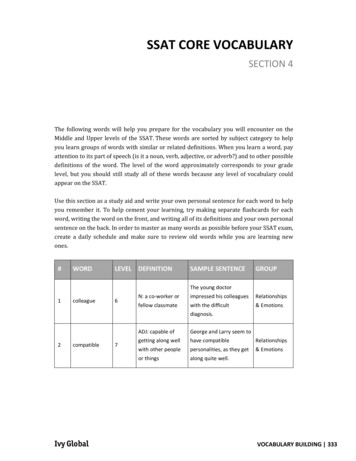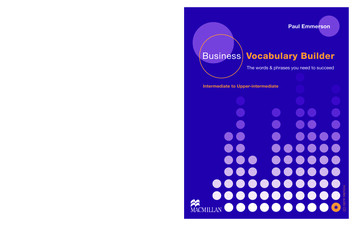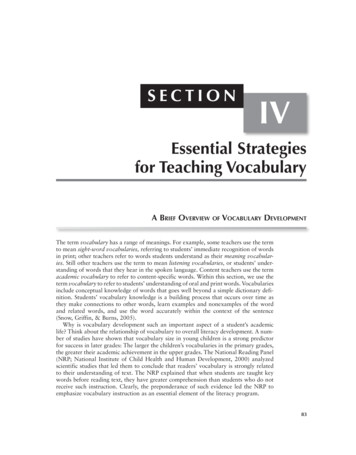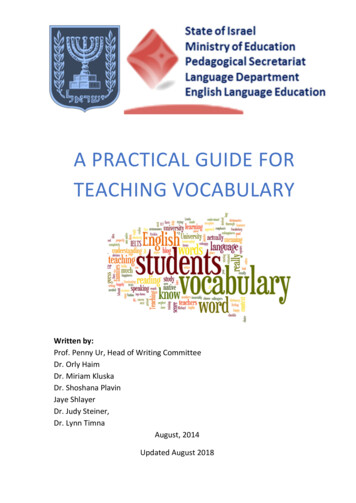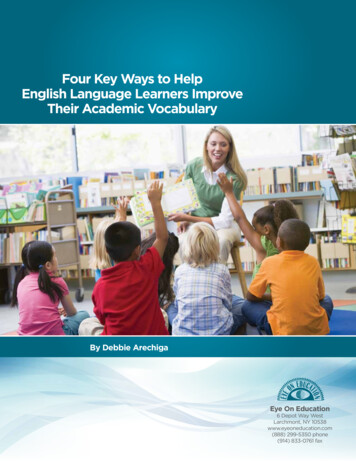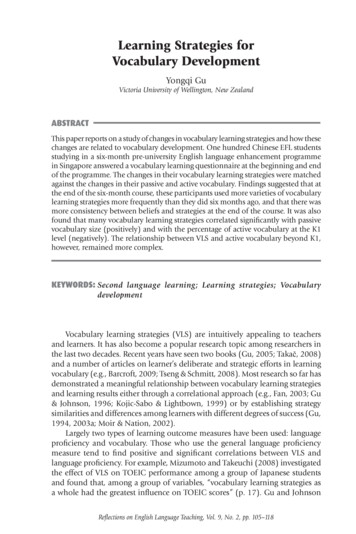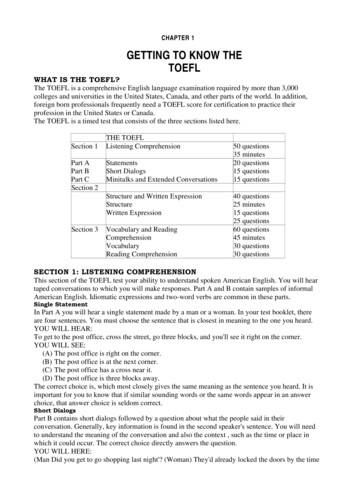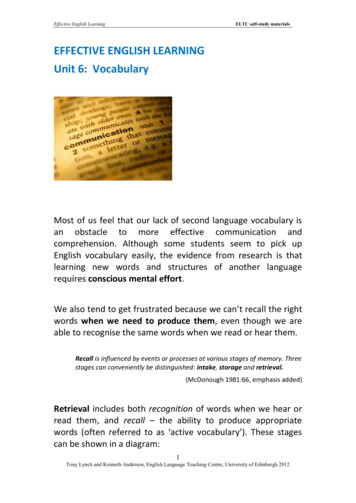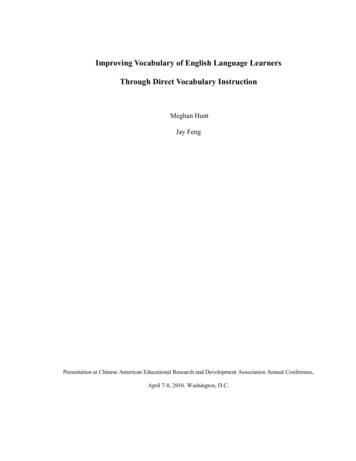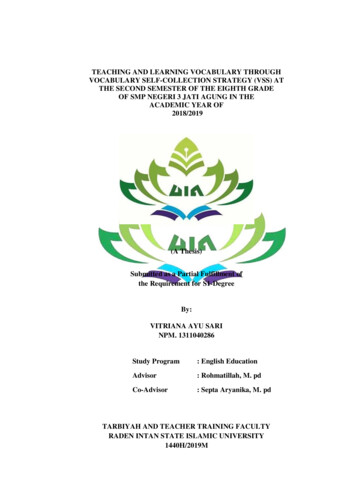
Transcription
TEACHING AND LEARNING VOCABULARY THROUGHVOCABULARY SELF-COLLECTION STRATEGY (VSS) ATTHE SECOND SEMESTER OF THE EIGHTH GRADEOF SMP NEGERI 3 JATI AGUNG IN THEACADEMIC YEAR OF2018/2019(A Thesis)Submitted as a Partial Fulfillment ofthe Requirement for S1-DegreeBy:VITRIANA AYU SARINPM. 1311040286Study Program: English EducationAdvisor: Rohmatillah, M. pdCo-Advisor: Septa Aryanika, M. pdTARBIYAH AND TEACHER TRAINING FACULTYRADEN INTAN STATE ISLAMIC UNIVERSITY1440H/2019M
ABSTRACTTEACHING AND LEARNING VOCABULARY THROUGHVOCABULARY SELF-COLLECTION STRATEGY AT THESECOND SEMESTER OF THE EIGHTH GRADE OF SMPN 3JATI AGUNG IN THE ACADEMIC YEAR OF 2018/2019BY :VITRIANA AYU SARIVocabulary is one of the important components in the language because withvocabulary students can understand speech or writings of other. This research wasabout teaching and learning vocabulary by using VSS at the second semester ofthe eighth grade of SMPN 3 Jati Agung in the academic year 2018/2019. Theobjectives of the research were to know the teaching and learning vocabulary byusing vocabulary self-collection strategy, to know the teacher‘s problem inteaching vocabulary by using vocabulary self-collection strategy, and to know thestudents‘ problem in learning vocabulary by using VSS.This research was qualitative research. The researcher selected the people orparticipants who know the phenomenon of the problem. The researcher chose theEnglish teacher and the students of the eighth grade of SMPN 3 Jati Agung as theparticipant of this research. There are two classes which consist of 64 students.The researcher used purposive sampling technique to the determine the sample.The researcher chose class VIII B as the sample because class had the lowestscore. The data were gained by doing observation, interviewing the teacher, andgiving questionnaire to the students. The researcher used three major phases of thedata analysis, they were: data reduction, data display and conclusion drawingverification.After analyzing the data, there were three points of the result. The first, there weresome points in teaching vocabulary by using vocabulary self-collection strategythat were skipped by the teacher. It could be seen from process in whilst activitythe teacher did not model how to select and nominate important words from thereadings, the teacher did not engage students in the process of vocabulary selfselection strategy. The second, the problems faced by the teacher were the teacherhad difficulty in teaching vocabulary when her students have different level oflearners, had difficulty when her students are likely familiarity with the words,had problem of the items, had difficulty in her teach ability, and had difficulty inmanage the time. Third, the problems by the students were students had problemin pronunciations, had problem in spelling and pronounce the difficult world likemelting words, had problem in length and complexity words, had problem inword grammar, and had problem with the word that has two meanings.Keywords : Qualitative Research, Teaching and Learning, Vocabulary,Vocabulary self-collection strategy
DECLARATIONThe researcher is a student with the following identity:Name: Vitriana Ayu SariStudents‘ Number: 1311040286Thesis: Teaching and learning vocabulary through VocabularySelf-collection Strategy at the second semester of the eighthgrade of SMPN 12 Kotabumi03 Jati Agung in the AcademicYear of 2018/2019.Certify that this thesis is definetely my own work. I am completely responsible forthe content of this thesis. Other researchers‘ opinions or findings included in thethesis are quoted or cited in accordance with ethical standards.Bandar Lampung, 6th June 2019Declared,Vitriana Ayu SariNPM. 1311040286
DEDICATIONPraise and gratitude to Allah the Almighty for His abundant blessing to me, andfrom my deep heart and great love, This thesis is dedicated to:1. The greatest inspirations in my life are my beloved parents, Mr. NimbangMarga and Mrs. Raden Mah Dewi who have always prayed and supportedfor my success and advised me.2. My beloved sister Dwisa Maya Sari and Trina Lisa Sari and my belovedRio Febriansyah brotherr, who always support me and cheer me up untilthe completion of this thesis.3. My beloved lecturers and Almamater UIN Raden Intan Lampung whichhas contributed a lot for my development.
CURRICULUM VITAEThe researcher‘s name is Vitriana Ayu Sari. She is called Vitri. She was born inTanah Abang on February 27th 1996. She is the fourth child of Mr. NimbangMarga and Mrs. Raden Mah Dewi. She has one beloved sister and one belovedbrother. Their names are Dwisa Maya Sari and Trina Lisa Sari and RioFebriansyah. She lives in Tanah Abang, Kotabumi, North Lampung.The researcher began her study in Elementary School at SDN 01 Tanah Abang in2001 and graduated in 2006. She continued her study in Junior High School atSMPN 02 Bunga Mayang and finished in 2009. At the time, she joined PMR forabout three years. After that, she went to Senior High School at SMAN 01Sungkai Utara and graduated 2012. After completing her study in Senior HighSchool, she decided to study in English Education Study Program of Tarbiyah andTeacher Training Faculty of Raden Intan State Islamic University Lampung.
ACKNOWLEDGEMENTIn the name of Allah, the most meaningful, the most beneficent. Praise be toAllah, the almighty God. For blessing Me with His mercy and guidance to finishthis thesis. The peace is upon our prophet Muhammad SAW, with his family andhis followers.This thesis is submitted as compulsory fulfillment of the requirements for S1degree of English Education study program at Tarbiyah and Teacher TrainingFaculty Raden Intan State Islamic University Lampung (UIN Raden IntanLampung).The researcher realizes that she cannot complete this thesis without help fromothers. The researcher has obtained a lot of help from many people during writingthis thesis and it would be impossible to mention all of them. She wishes,however, to give her sincerest gratitude and appreciation to:1.Prof. Dr. Hj. Nirva Diana, M.Pd., the dean of Tarbiyah and Teacher TrainingFaculty, UIN Raden Intan Lampung with her stafs, who have given andopportunity and for bearance to the researcher when on going the study untilthe accomplishment of this thesis.2.Meisuri, M.Pd., as the chairperson of English Education study program UINRaden Intan Lampung.3.Rohmatillah, M.Pd., as first advisor, who alwaysresearcher until the completion of this thesis.patiently guided the
4.Septa Aryanika, M.Pd, as the Co-Advisor, for the patience in giving guidanceand support for the finalization of the thesis.5.Soetopo, S.Pd., the headmaster of SMPN 3 Jati Agung. Ita Meiriyanti, S.Pd,the English teacher, also teacher and staff there for allowing her to carry outthis research in their instruction and for giving contribution while she wasconducting the research there.6.All the students of the second semester of the eighth grade of SMPN 3 JatiAgung in the Academic Year of 2018/2019. For giving nice perticipation andgreat attention during the process in this research.7.All lecturers of the English Departement of UIN Raden Intan Lampung whohave tought the researcher since the first year of her study.8.The researcher‘s friends especially, Muhammad Nur Muqqodis, Ella Putri,Egi, Reci Adhya Fiscarina, Melisa Hertika putri, and others who cannot bementioned individually here.Finally, the researcher is fully aware that there are still a lot of weaknesses in thisthesis. For this, the researcher truthfully expected criticism and suggestion fromthe readers to enhance the quality of the thesis.Bandar Lampung,The Researcher,Vitriana Ayu SariNPM. 13110402862019
CHAPTER IINTRODUCTIONA. Background of the ProblemVocabulary is one of the important components in the language becausewith vocabulary students can understand speech or writings of other. Incommunication, students need vocabulary which can support them to produce anduse meaningful sentence because vocabulary provides organ of sentence. That iswhy, vocabulary is very important to be mastered.Vocabulary is basic elements to learn a language and to make acommunication with another people. It is impossible to learn English if thestudents are lack of vocabulary. Cameron says vocabulary is fundamental to usingthe foreign language as discourse.1 Moreover, Thronbury says that vocabularyplays an important role in language; because without vocabulary it is impossibledevelop language.2 Finally, to communication with another people we mustmaster vocabulary, because without vocabulary we cannot communicate eachother.Vocabulary is the most important part in English; we cannot say anythingwithout mastering vocabulary. Thronbury states without grammar very little canbe conveyed, without vocabulary nothing can be conveyed. 3 It means thatvocabulary is one important aspect in learning language. We should have anadequate vocabulary to improve the four language skills. Only with sufficientvocabulary we can express our ideas effectively, can understand the language taskand foreign language conversation. By having limited vocabulary the students willhave the difficulties in learning and understanding the foreign language. That is1Lyne Cameron, Teaching Learning to Young Learning to young learners, (London :Cambridge university press, 2002), p.42Thornbury, Oxford Advance Learn Dictionary of Correct English, (Oxford : 1984), p.53Scoot Thronbury, How to Teach Vocabulary (London: Longmand, 2002),p.13
way the appropriate strategy in delivering lesson in the classroom should beconsidered. One of the strategy is vocabulary self-collection strategy.Vocabulary self-collection strategyis first introduced by Haggard then hasbeen adapted for various grade levels and instructional contexts. 4 VocabularySelf-Collection Strategy (can be applied every grade level.5In teaching andlearning vocabulary, there are many kinds of media and games used to increasestudents‘ vocabulary. One of strategy is vocabulary self-collection strategy. Thevocabulary self-collection strategy is an interactive-learning instructional strategythat promotes word consciousness, as students are actively engaged in identifyingimportant words from their reading to share with members of their class. 6Students select words from their readings that are new and interesting, use thecontext and other resources to determine the meaning of the words, and nominatethe words to be learned by others in the group or class.Teachers using the vocabulary self-collection strategy (1) model theprocess of collecting words, (2) provide guided practice within reading groups andother instructional contexts, and (3) offer consistent encouragement to students touse vocabulary self-collection strategy during independent reading.7 The majorbenefits of using vocabulary self-collection strategy are that students engage intheir own learning, discover how to recognize unfamiliar or interesting wordsfrom their readings, develop their vocabularies, and become word conscious.After doing preliminary research, which was conducted at SMPN 3 JatiAgung, the researcher found that teaching and learning vocabulary by usingvocabulary self-collection strategy had been applied there. On the contrary, the4Haggard, M. R. (1982). The Vocabulary Self-Collection strategy: An active approach toword learning. Journal of Reading, 27(3),pp. 88.5Ibid, p.88.6Ibid, p.88.7Ibid, p.88.
researcher found that the students‘ vocabulary was still low although the teacherhad used vocabulary self-collection strategy. By interviewing an English teacherthere, Ita Meiriyanti, S.Pd, she said that she had used vocabulary self-collectionstrategy in teaching and learning vocabulary, but the students are still confused toread the material in English because lack vocabulary mastery, she added that thestudents‘ ability in vocabulary was still low.8This case showed that applying this strategy still cannot improve thestudents‘vocabulary ability. It can be seen as the following table of the students‘score of vocabulary. It is described with the data. Here is the detail of the data:Table 1The Students’ vocabulary Score at the Second Semester of the Eighth Gradeof SMPN 3 Jatiagung in the Academic Year of 2018/2019NoClassScoreNumber ofStudents 72 721VIII A2012322VIII B181432Total382664Percentage59.4%40.6%100%Source : The Score Data from English Teacher of SMPN 3 JatiagungThe table shows that from the total of the students of eighth grade, thereare 26 students achieved score above KKM, but more than it, 38 students gotscore under KKM, and the criterior of minimum mastery (KKM) at eighth gradeof SMPN 3 Jati agung is 72. It could be inferred that most of students still haddifficulties in their vocabulary although they had been taught by using selfcollection strategy. Moreover, by interviewing the students, thay did not focus ontheir lesson because they lazy and lost motivation in learning and they felt so8Meiriyanti Ita,S.pd An English Teacher at SMPN 3 Jati Agung. An Interview, onThursday, August 9, 2018, unpublished.
difficult to learn.Based on the background above, the researcher conducted aresearch entitled Teaching and Learning vocabulary through vocabulary selfcollection strategy at the second semester of the eighth grade of SMPN 3Jatiagung in 2018/2019 academic year.There are some previous researcher about teaching and learningvocabulary through vocabulary self-collection strategy, one of the research wasconducted by Safitri Noor Fatonah (2015) using vocabulary self-collectionstrategy to improve reading comprehension. The research findings showed thatreading comprehension of most students improved after the vocabulary selfcollection strategy was used in the teaching and learning process. It was indicatedby the increase of the mean of students‘ reading comprehension scores in the pretest and post-test (58.9 to 78.0). so, the research hypothesis is accepted. It can helpthe students to improve reading comprehension especially in vocabulary. 9The other previous research is a related in teaching and learningvocabulary through Vocabulary Self-Collection Strategy, one of the research wasconducted by Masrukhan Al Maghfuri, he says on his thesis entitled ―improvingvocabulary mastery using vocabulary self-collection strategy‖.He finds of the research analysis the action in the form of teachingvocabulary by using vocabulary self-collection strategy revealed that it couldimprove in two cycles. It could be seen from based standard of minimal Englishsubject score especially in mastering vocabulary at MTs muna ponorogo was 70,and standard minimal of students‘ activeness was 75 %. The results of the action9Safitri Noor Fatonah, Using Vocabulary Self Collection Strategy to Improve ReadingComprehension of the Seventh Grade f SMPN 4 Kalasan, S1 Thesis, Yogyakarta: YogyakartaState University, Unpublished, 2015, p. 11
aimed increase students‘ activeness in learning from 68.75 % of 16 students in thefirst cycle to 85.45 % of 16 students in the second cycle. Moreover, the students‘vocabulary mastery improved from 62.5 % of students in the first cycle to 93.75% of 26 students in the second cycle. Based on the results above, it can beconcluded that the implementation of vocabulary self-collection strategy canimprove students‘ vocabulary mastery at eighth grade students‘ of MTs HudatulMuna Ponorogo in the academic year of 2016/2017.10The current research vocabulary self-collection strategy will be conductedto teach reading comprehension by the teacher. The researcher only observes theteaching and learning process. The purpose of previous research is to know theinfluence of using vocabulary self-collection strategy towards students‘vocabulary. Meanwhile, the purpose of current research is to know the processand also the problem of teaching and learning vocabulary by using vocabularyself-collection strategy.Based on the background above, the researcher will conduct a researchentitled Teaching and Learning Vocabulary through vocabulary self-collectionstrategy at the Second Semester of the Eighth Grade of SMPN 3 Jati Agung in the20018/2019 Academic Year.B. Identification of the ProblemReferring to the background of the problem above the research identifiesthe problems as follows:1. The students‘ score in vocabulary was still low.10Masrukhan Al Maghafuri, improving vocabulary mastery using vocabulary self-collectionstrategy.(Stain Ponogoro. 2017)p.2
2. The students still get difficulties in mastery vocabulary.3. The English teacher had used vocabulary self-collection strategy inteaching vocabulary but it was not effective and not maximal.C. Limitation of the ProblemThe researcher limits the problems that focuses on the process of teachingand learning vocabulary through vocabulary self-collection strategy and theproblem faced by the teacher and the students at the second semester of the eighthgrade of SMP Negeri 3 Jati Agung.D. Formulation of the ProblemThe researcher formulates the research problems as follows:1. How is the process of teaching vocabulary through vocabulary selfcollection strategy at the second semester of the eighth grade of SMPNegeri 3 Jati Agung?2. What are the teachers‘ problems during the process of teaching vocabularythrough vocabulary self-collection strategy at the second semester of theeighth grade of SMP Negeri 3 Jati Agung?3. What are the students‘ problems during the process of learning vocabularythrough vocabulary self-collection strategy at the second semester of theeighth grade of SMP Negeri 3Jati Agung?E. Objective of the ResearchBased on the formulation of the problem above, the objectives of theresearch are as follows:
1.To know and describe the process of teaching vocabulary throughvocabulary self-collection strategy at the second semester of eighth gradeat SMP Negeri 3 Jati Agung 2018/2019 academic year.2.To know and describe the teacher‘s problems in the process of teachingvocabulary through vocabulary self-collection strategy at the second ofeighth grade at SMP Negeri 3 Jati Agung in 2018/2019 academic year.3.To know and describe the students‘ problems in the process of learningvocabulary through vocabulary self-collection strategy at the second ofeighth grade at SMP Negeri 3 Jati Agung in 2018/2019 academic year.F. Uses of the ResearchThe researcher expectes the result of the research can be used:1. Theoretically, this research is expected to support the previous theoriesabout teaching and learning vocabulary through vocabulary self-collectionstrategy and to develop knowledge of the researcher in practising thetheories.2. Practicallya. For students, it is expected to make students more interested andmotivated to learn English so that their English vocabulary will bedeveloped and will have a positive effect on their English achievement.b. For the teacher, it is expected that to increase teacher‘s creativity in theteaching and learning process so that learning objectives can beachieved.
c. For other researcher, it is expected that other researcher would be as areference to another relevant research by using team vocabulary selfcollection strategy.d. For the school, it is expected that research could provide useful input inimproving the quality of learning in the school.G. Scope of the ResearchThe researcher will devide the scope of the research into four parts, they are:1. Subject of the ResearchSubject of the research will be students and the English teacher at thesecond semester of the eighth grade student at SMP Negeri 3 Jati Agung in2018/2019 academic year.2. Object of the ResearchObjects of the research will be teaching and learning vocabulary andvocabulary self-collection strategy.3. Time of the ResearchThe research will be conducted in 2018/2019 academic year.4. Place of the ResearchThe research place will be conducted at SMP Negeri 3 Jati Agung.
CHAPTER IIREVIEW OF RELATED LITERTUREA. Vocabulary1. Definition of VocabularyVocabulary is one of language components that plays an important role inlearning a language. If the students English vocabulary mastery is limited, theywill find some difficulties in using English for the aim of communication.Vocabulary is the set of words for which we know the meanings when we speakor read orally and the set of words also that an individual can use when eriting. 11In order to be able to communitcate in English, the students will master adequatepersonal English vocabularies that cover needs for communication in real lifesituation.Vocabulary is basic to learn a language and make communication witheach other fluently, it is impossible to learn a language without vocabulary.12 Theexplanation above, vocabulary is fundamental to sing the foreign language asdiscourse. Furthermore, it would be impossible to learn a language withoutvocabulary.13 It means that they will do nothing for interaction if they do notknow vocabulary is a vital aspect of the language.Based on explanation above vocabulary is language, so, vocabulary is thebase of language communication. Through vocabulary, we can know the11Elfrida. H. Hiebert and Michael L. Kamil, Teaching and Learning Vocabulary,Bringing Research to Practice. Lawrence Arlbaum Associate, New Jersey, Mahwa Publisher,2005.p.10.12Lyne Cmeron, Teaching Language to Young Learners, London. Cambridge UniversityPress. 2002.p.45.13Michael Wallace, Teaching Vocabuary, New York. Henemen EducationBook.1998.p.123.
meanings when we speak or read the text. In other words, the students will getsome vocabularies as the introduction of a language.1. Types of VocabularyThere are two kinds of vocabulary. According to Haycraft, they arereceptive vocabulary and productive vocabulary. 14 The receptive vocabulary iswords that the students recognize and understand when they occur. In anotherword, this vocabulary depends on the context. The productive vocabulary is thewords which the students understand, pronounce correctly, and use constructivelyin writing ability.On the other hand, Hiebert and Kamil vocabulary is the knowledge ofmeanings of words. What complicates this definition is the fact that words comein at least two forms: oral and print. Knowledge of words also comes in at leasttwo forms, receptive—that which we can understand or recognize—andproductive—the vocabulary we use when we write or speak. 15 It can be said thatoral vocabulary refers to the words that their meanings are known in speaking orreading orally, whereas the print vocabulary is considered as the words of whichtheir meanings may be known in writing or reading. Kamil and Heibert also say:The productive vocabulary is the words that are familiar or easy to recognizeandthese are often used by an individual, particularly in writing and speaking; incontrast, the receptive vocabulary is the words that are less familiar to students aswell as are considered being less to be used or the students may not use thesespontaneously for they may recognize the words‗ meaning as they are reading andlistening.1614J Haycraft, An Introduction to English Language Teaching, (Singapore: LongmanPublishers Pte Ltd: 2007), p.15615Michael L. Kamil and Elfrieda H. Hiebert, Teaching and Learning Vocabulary, (NewJersey: Mahwah), 2005, p. 316Ibid, p.3
It can be said kind of vocabulary are receptive or the passive vocabularyand productive is the active vocabulary. There are some words in making a textand those collections of words include to the vocabulary because vocabulary is alist or collection of words arranged in alphabetical order and explain.Fromkin, Rodman, and Hyams classify words in a language into two terms, i.e.content and function words. The content word is such as actions, objects,attributes, and ideas. It consists of noun, verb, adjective, and adverb. Meanwhile,the function word is a word that does not have clear concepts or meaning relatedto the word and it is only used in terms of grammatical function. It consists ofpreposition (such as in,on), article (such as a/an, the), and pronoun (such as he,she, it).17Based on the explanation above, it can be concluded that vocabulary maybe categorized based on the division of the language skills. In this case, theproductive vocabulary is associated with the productive language skillscomprising speaking and writing skills, whereas the receptive vocabulary isassociated with the receptive skills which consist of listening and reading.Besides, other categories of vocabularies, oral and print vocabularies, refers to theforms of vocabulary of which meaning may be obtained in speaking or readingloudly or orally (in the case of the oral vocabulary) as well as may be obtained inreading writing or reading silently (in the case of the print vocabulary). Besides, itmay be categorized or classified based on its parts of speech or word classes.According to Thornburry, in learning vocabulary there are classification of word.They are noun, verb, adjective, adverb, conjuctions, determiner, pronoun, andpreposition.18 These will explain clearly as follows :17Victoria Fromkin, et.al, An Introduction to Language, (7th Ed), (Boston: Wadsworthengage learning, 2003), pp. 73-7418Scott Thornburry, How to Teach Vocabulary, (Essex: Longman Pearson EducationLimited, 2002), p.3
a. NounAccording to Frank, noun is one of the most important parts of speech. Itsarrangement with the verb helps to form the sentence care which is essential toevery complete sentence. In addition, it may function as the chief or head word inmany structures of modification.19There are some main types of nouns, namely common nouns (words forpeople, place, and things are called common noun), proper nouns (the names ofparticular people, place, and things), countable noun and uncountable noun, andplural noun.1). Common NounsThese are names of everyday things that we can see, hear, and touch.20 Thesekinds of common noun:a) Common nouns are words for thingsThese common nouns are words for things: ruler, chair, hammer, bicycle, truth,pen, table, saw, calculator, crayons, sofa, axe, truck,television, pencil, loyalty, drill, ferry, fridge, book, lamp, ladder, train, cooker,dictionary, carpet, lawnmower, bus, computer, courage, telephone, spade,laziness printer, etc.b) Common nouns are words for animalsThese common nouns are words for animals: dog, puppy, cat, kitten, cow, calf,horse, foal, sheep, lamb, goat, kid, frog, tadpole, etc.c) Common nouns are words for places1920Marcella Frank, Op. Cit, p. 7Dykes Barbara, Grammar for Everyone, (Victoria Acer Press, 20011), p. 22
These common nouns are words for places: bank, airport, hotel gas station,library, park, museum, farm, mall, zoo, theater, factory, hospital, nursery, etc.d) Common nouns are words for people who do certain thingsThe common nouns are words for people who do certain things: singer, manager,sailor, gardener, dancer, secretary, pilot, police, officer, etc.212). Proper NounAs mentioned before the proper noun is word that showed about names ofparticular people, places, and things. According to Sargeant, there are some kindsof proper noun such as:-The people‘s names people‘s names are proper nouns. Such as: Robbin Hood,Florence, etc.-The names of the days of the week and the moths of the year are propernouns.-The names of special days and celebrations are also proper nouns.-The names of people who live in a particular country are also proper nouns.223). Concrete and Abstract NounsA concrete noun is a word for a physical object that can be perceived bythe sentence, we can see, touch, smell the object (flower, girl). An abstract noun isa word for a concept, it is an idea that exists in our minds only (beauty, justice,mankind).2321Howard Sargeant, Basic English Grammar, (Essex: Saddleback EducationalPublishing, 2009), p. 7-822Ibid, Pp. 8-923Marcella Frank, Op.Cit, Pp. 6-7
4). Countable and Uncountable NounsCountable noun (singular noun) can be singular or plural: oven(s),exercise(s), etc. We use countable noun separate individual things such as ovensand exercises, things we can count. Many countable nouns are concrete: table(s),car(s), but some are abstract: situation(s), idea(s).24b. VerbVerb usually denote processes, actions or states.25 In activities ( run, walk,look, for), accomplishment (build, kill), achievement (recognize, find) and states(know, love, have).For example in sentence :We walked to the store yesterdayThe kinds of verbs are :1)Intransitive VerbsIntranstive verbs are verb that do not take an object or subject attribute in thsentence.26 Example in sentence: he is reading2)Transitive VerbsTransitive verbs are verbs that take a direct object in the sentence.Example in sentence :He has read a bookHe turned the page3)Distransive Verbs24Howard Sargeant, Op.Cit, p. 11.Marjolijn Verspoor and Kim Sauter, English Sentence Analysis: An Intoductory :Course (Amsterdam : John Benjamins Ppublishing Company, 2000), p.9126Ibid, P.6525
Distransitive verbs are verbs that take two objects in the sentence : a direct objecttelling ―what‖ or ―whom‖ and indirect object telling ―to‖ or ―for whom― the directobject is sent, give, buy, and so on. 27Example :He gave me a bookHe gave a book to meFrom the statement above, the researcher concludes that verbs is a wordthat the most complex part of speech and show measure and condition of a thing.Verbs has the grammatical properties of person and number, properties whichrequire agreement with the subject.c. AdjectiveAdjective is the word that typically refers to the properties which belongsto people or things and its function is to modify a noun.28The types of adjective are :1) DeterminersThey are aticles (the, an, a), demonstrative adjective (this, that, these, those),possive adjectives (my, your, her), numeral adjective (fourth, first, tenth, third),and adjectives of indefinite quantity (some, few, all).2) Descriptive adjectivesThey usually indicates an inherent quality (old, young, new) or a physical state(blue, red, yellow), size or age.27Ibid, p.67Andrew Radford, et.al
Vocabulary is one of the important components in the language because with vocabulary students can understand speech or writings of other. This research was about teaching and learning vocabulary by using VSS at the second semester of the eighth grade
